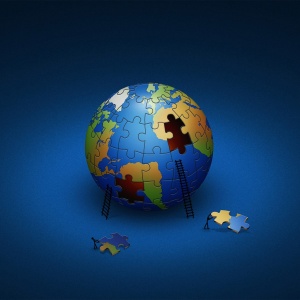In days gone by, the world was conceived as a giant jigsaw puzzle. Each piece represented a country. Although all the pieces could be placed together to form the one picture, the final image remained fractured, with each segment isolated within its own boundaries.
While countries may be still separated by geographical and political barriers, in a way the world’s population behaves as a singular organism in which invisible products in the form of information, ideas and commentary flow fluidly around the globe. Within this interconnected environment, ‘media capitals’ have emerged as centres of media activity, locations where complex information paths and products interact, and where cultural boundaries dissolve. Today, the frontrunners of the media landscape are cities that act as hubs for finance, production, and the distribution of media, including Bombay, Cairo, Hollywood and Hong Kong (Curtin, 2003).
However within this unified media ecology, it has become clear that the concept of “cultural essentialism” holds true, the idea that certain cultural traits and characteristics do not change over time. In particular, this concept can be embodied in the orientalist opposition between the east and the west.
The Australian reporting of a number of attacks on Indian students in Australia in 2009 caused international controversy, representing to many the begrudging acceptance of the west to shifts in media power to those media capitals in the east (Khorana, 2012). Australian newspapers, such as the Age, responded to the attacks by blaming Indian TV as creating ‘hysteria’, lacking in balance and reporting sensational and exaggerated facts. This scenario followed a string of controversial interactions between the two countries, including an alleged racist comment made by an Indian cricketer to an Australian player in 2008. Following on from the attacks, India proclaimed that Australia was an inherently racist country.
Such an incident reveals that, despite the cultural flows facilitated through media capitals and by globalisation, countries remain firm in defending their self-interests and cultural characteristics against external challengers.
Another clear example of countries asserting their cultural independence over the world stage is the controversy surrounding supposed weapons of mass destruction in Iraq. In 2003, the UN and the Bush government of the US declared that Saddam Hussein was in the possession of large stockpiles of WMD. The media itself became a weapon of “mass hysteria that created tremendous fear in the population”, before it was exposed in 2008 by the Senate Intellgience Committee that the Bush administration had misrepresented the intelligence in an attempt to justify the war. In this scenario, the paranoia of the US post 9/11 saw America take all possible measures to protect itself and its self-interests against international threats at the same time ignoring the facts.
As can be seen, while it is true in many respects that the world has become one entity through which products, ideas and cultures flow, it is clear that the concept of “cultural essentialism” holds true. Embodied in cultural differences and expressions of countries’ self-interests, perhaps the world really is still a giant jigsaw puzzle.
